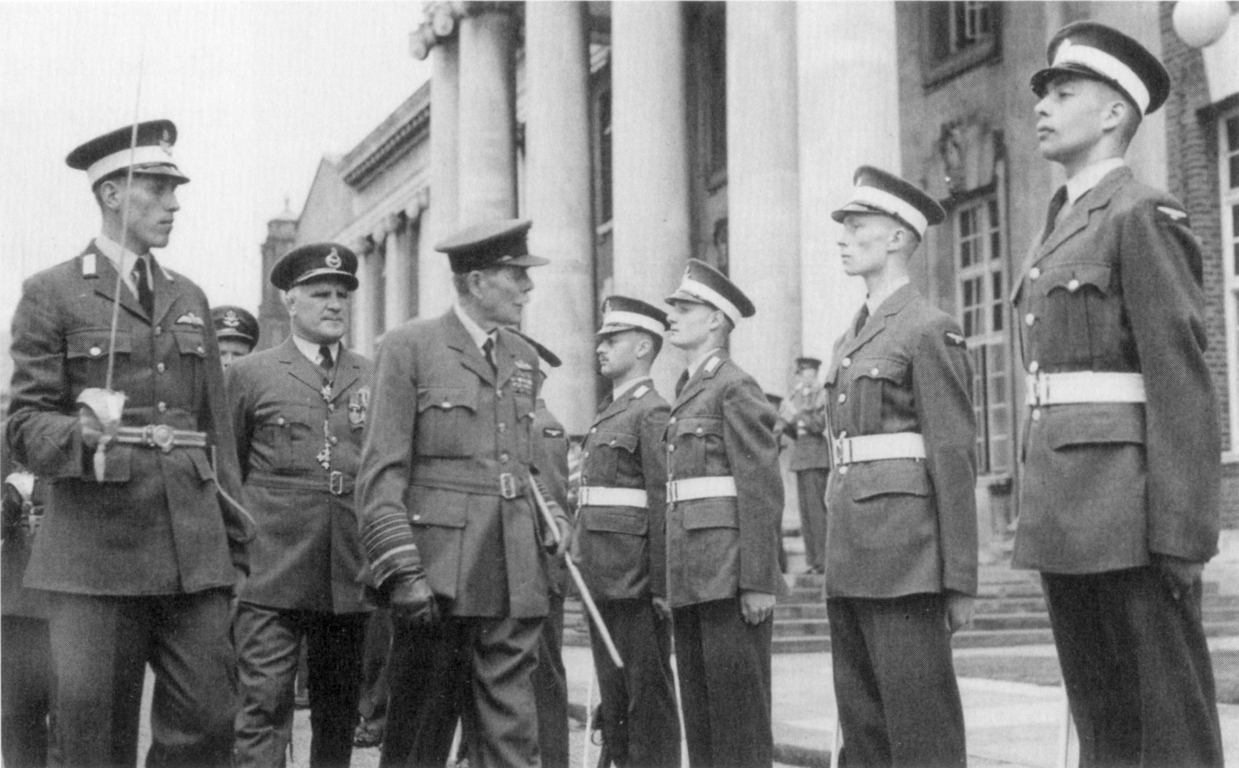|
Vickers Varsity
The Vickers Varsity is a retired British twin-engined crew trainer operated by the Royal Air Force from 1951 to 1976. Design and development The Varsity was developed by Vickers and based on the Viking and Valetta to meet Air Ministry Specification T.13/48 for a twin-engined training aircraft to replace the Wellington T10 and the Valetta T3 and T4. The main differences were the wider-span wings, longer fuselage and tricycle undercarriage. There was also a ventral pannier to allow a trainee bomb aimer to lie in a prone position and a bomb bay with a capacity for 24 x 25lb smoke & flash bombs. The first prototype Type 668 Varsity VX828 was first flown by J 'Mutt' Summers and G R 'Jock' Bryce from Wisley on 17 July 1949. A civil version the VC.3 was planned but with the success of the VC.2 Viscount the idea was abandoned. Operational history The Varsity was introduced to replace the Wellington T10 trainer. Following deliveries to trials units the first production aircraft ... [...More Info...] [...Related Items...] OR: [Wikipedia] [Google] [Baidu] |
Trainer (aircraft)
A trainer is a class of aircraft designed specifically to facilitate flight training of pilots and aircrews. The use of a dedicated trainer aircraft with additional safety features—such as tandem flight controls, forgiving flight characteristics and a simplified cockpit arrangement—allows pilots-in-training to safely advance their skills in a more forgiving aircraft. Civilian pilots are normally trained in a light aircraft, with two or more seats to allow for a student and instructor. Tandem and side by side The two seating configurations for trainer aircraft are: pilot and instructor side by side, or in tandem, usually with the pilot in front and the instructor behind. The side-by-side seating configuration has the advantage that pilot and instructor can see each other's actions, allowing the pilot to learn from the instructor and the instructor to correct the student pilot. The tandem configuration has the advantage of being closer to the normal working environment tha ... [...More Info...] [...Related Items...] OR: [Wikipedia] [Google] [Baidu] |
ELINT
Signals intelligence (SIGINT) is intelligence-gathering by interception of '' signals'', whether communications between people (communications intelligence—abbreviated to COMINT) or from electronic signals not directly used in communication (electronic intelligence—abbreviated to ELINT). Signals intelligence is a subset of intelligence collection management. As classified and sensitive information is usually encrypted, signals intelligence in turn involves the use of cryptanalysis to decipher the messages. Traffic analysis—the study of who is signaling whom and in what quantity—is also used to integrate information again. History Origins Electronic interceptions appeared as early as 1900, during the Boer War of 1899–1902. The British Royal Navy had installed wireless sets produced by Marconi on board their ships in the late 1890s, and the British Army used some limited wireless signalling. The Boers captured some wireless sets and used them to make vital tr ... [...More Info...] [...Related Items...] OR: [Wikipedia] [Google] [Baidu] |
Empire Test Pilot's School
The Empire Test Pilots' School (ETPS) is a British training school for test pilots and flight test engineers of fixed-wing and rotary-wing aircraft at MoD Boscombe Down in Wiltshire, England. It was established in 1943, the first of its type. The school moved to RAF Cranfield in October 1945, then to the Royal Aircraft Establishment, Farnborough in July 1947, before returning to Boscombe Down on 29 January 1968. Its motto is "Learn to test; test to learn". ETPS is run by the MoD and defence contractor QinetiQ under a long-term agreement. History In 1943, Air Marshal Sir Ralph Sorley, Controller, Research and Development, MAP, formed the "Test Pilots' Training Flight" at RAF Boscombe Down after many pilots died testing the many new aircraft introduced during the Second World War. On 21 June 1943, the unit became the ''Test Pilots' School'' within the Aeroplane and Armament Experimental Establishment (A&AEE) at Boscombe Down. The school was "to provide suitably trained p ... [...More Info...] [...Related Items...] OR: [Wikipedia] [Google] [Baidu] |
Central Flying School
The Central Flying School (CFS) is the Royal Air Force's primary institution for the training of military flying instructors. Established in 1912 at the Upavon Aerodrome, it is the longest existing flying training school. The school was based at RAF Little Rissington from 1946 to 1976. Its motto is ''Imprimis Praecepta'', Latin for "The Teaching is Everlasting". The school currently manages a series of training squadrons and the RAF Display Team. History The Central Flying School was established by the Royal Navy at Upavon Aerodrome, near Upavon, Wiltshire, on 12 May 1912. The school's strength at the outset was ten Staff Officers and eighty flying students, whose course lasted for sixteen weeks.Hugh Soar, ''Straight & True'' (2012), p. 87 Its first commandant was Captain Godfrey Paine RN, and it also trained pilots for the Royal Flying Corps, created in 1912, and the Royal Naval Air Service, 1914–1918. The school was transferred from the Southern Training Bridge to HQ ... [...More Info...] [...Related Items...] OR: [Wikipedia] [Google] [Baidu] |
Royal Air Force College Cranwell
The Royal Air Force College (RAFC) is the Royal Air Force military academy which provides initial training to all RAF personnel who are preparing to become commissioned officers. The College also provides initial training to aircrew cadets and is responsible for all RAF recruiting along with officer and aircrew selection. Originally established as a naval aviation training centre during World War I, the College was established as the world's first air academy in 1919. During World War II, the College was closed and its facilities were used as a flying training school. Reopening after the War, the College absorbed the Royal Air Force Technical College in 1966. The Royal Air Force College is based at RAF Cranwell near Sleaford in Lincolnshire, and is sometimes titled as the Royal Air Force College Cranwell. History Early years In December 1915, after the Royal Naval Air Service had broken away from the Royal Flying Corps, Commodore Godfrey Paine was sent to Cranwell to start a ... [...More Info...] [...Related Items...] OR: [Wikipedia] [Google] [Baidu] |
Central Navigation And Control School
Central is an adjective usually referring to being in the center of some place or (mathematical) object. Central may also refer to: Directions and generalised locations * Central Africa, a region in the centre of Africa continent, also known as Middle Africa * Central America, a region in the centre of America continent * Central Asia, a region in the centre of Eurasian continent * Central Australia, a region of the Australian continent * Central Belt, an area in the centre of Scotland * Central Europe, a region of the European continent * Central London, the centre of London * Central Region (other) * Central United States, a region of the United States of America Specific locations Countries * Central African Republic, a country in Africa States and provinces * Blue Nile (state) or Central, a state in Sudan * Central Department, Paraguay * Central Province (Kenya) * Central Province (Papua New Guinea) * Central Province (Solomon Islands) * Central Province, Sri La ... [...More Info...] [...Related Items...] OR: [Wikipedia] [Google] [Baidu] |
Bomber Command Bombing School RAF
A bomber is a military combat aircraft designed to attack ground and naval targets by dropping air-to-ground weaponry (such as bombs), launching torpedoes, or deploying air-launched cruise missiles. The first use of bombs dropped from an aircraft occurred in the Italo-Turkish War, with the first major deployments coming in the First World War and Second World War by all major airforces causing devastating damage to cities, towns, and rural areas. The first purpose built bombers were the Italian Caproni Ca 30 and British Bristol T.B.8, both of 1913. Some bombers were decorated with nose art or victory markings. There are two major classifications of bomber: strategic and tactical. Strategic bombing is done by heavy bombers primarily designed for long-range bombing missions against strategic targets to diminish the enemy's ability to wage war by limiting access to resources through crippling infrastructure or reducing industrial output. Tactical bombing is aimed at countering en ... [...More Info...] [...Related Items...] OR: [Wikipedia] [Google] [Baidu] |
Aeroplane And Armament Experimental Establishment
The Aeroplane and Armament Experimental Establishment (A&AEE) was a research facility for British military aviation from 1918 to 1992. Established at Martlesham Heath, Suffolk, the unit moved in 1939 to Boscombe Down, Wiltshire, where its work continues following privatisation as part of the Qinetiq company. History In 1917, the Experimental Aircraft Flight of the Central Flying School was transferred from Upavon, Wiltshire to a site on the heathland at Martlesham, Suffolk, and on 16 January 1917 Martlesham Heath Airfield was officially opened, as an experimental airfield. The unit was renamed the Aeroplane Experimental Unit, Royal Flying Corps. After the end of World War I the site continued to be used and was, once again, renamed as the Aeroplane and Armament Experimental Establishment of the Royal Air Force. At the outbreak of the Second World War, on 9 September, the A&AEE was removed to RAF Boscombe Down, Wiltshire, owing to the proximity of Martlesham Heat ... [...More Info...] [...Related Items...] OR: [Wikipedia] [Google] [Baidu] |
Royal Jordanian Air Force
The Royal Jordanian Air Force (RJAF; ar, سلاح الجو الملكي الأردني, Silāḥ ul-Jawu al-Malakī 'al-Urdunī) is the aerial warfare branch of the Jordanian Armed Forces. History Early days Jordan gained independence in 1946, but its first air bases had been set up in 1931 by the Royal Air Force. By 1948, Jordan began to develop a small air arm which came to be known as the Arab Legion Air Force (ALAF). The Royal Air Force assisted in training this small air arm and provided equipment. The ALAF's primary fighter was the de Havilland Vampire and a Vickers VC.1 Viking was operated as a VIP aircraft for use by the King of Jordan. By 1955 King Hussein realized the need for Jordan to have a more modern air force, and on 25 September 1955 the RJAF was established. By 1958 the Royal Air Force had left Jordan and the RJAF had taken control of the airfields in the country. 1960s In 1967, in the Six-Day War, the Israeli Air Force relentlessly attacked Jordan's A ... [...More Info...] [...Related Items...] OR: [Wikipedia] [Google] [Baidu] |
RAF Museum
The Royal Air Force Museum is a museum dedicated to the Royal Air Force in the United Kingdom. The museum is a non-departmental public body of the Ministry of Defence and is a registered charity. The museum is split into two separate sites: * Royal Air Force Museum London, opened 1972 * Royal Air Force Museum Cosford The Royal Air Force Museum Cosford, located in Cosford, Shropshire, Cosford in Shropshire, is a free (currently, 2022) museum dedicated to the history of aviation and the Royal Air Force in particular. The museum is part of the Royal Air Force Mu ..., opened 1979 See also * Simon Greenish, former Director of Collections * Maggie Appleton, CEO References External links Official website {{Authority control Ministry of Defence (United Kingdom) Non-departmental public bodies of the United Kingdom government Air force museums in the United Kingdom ... [...More Info...] [...Related Items...] OR: [Wikipedia] [Google] [Baidu] |






.jpg)
